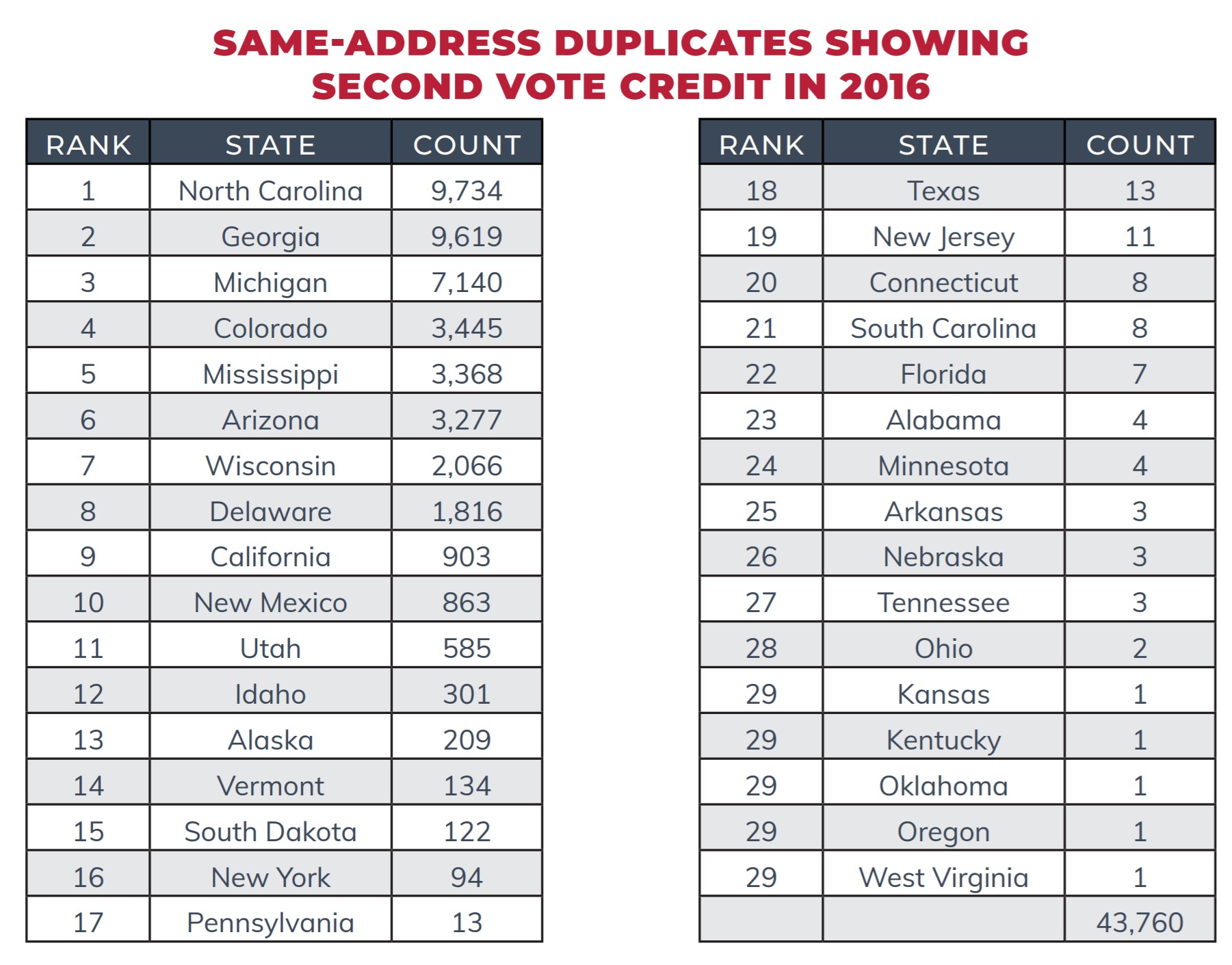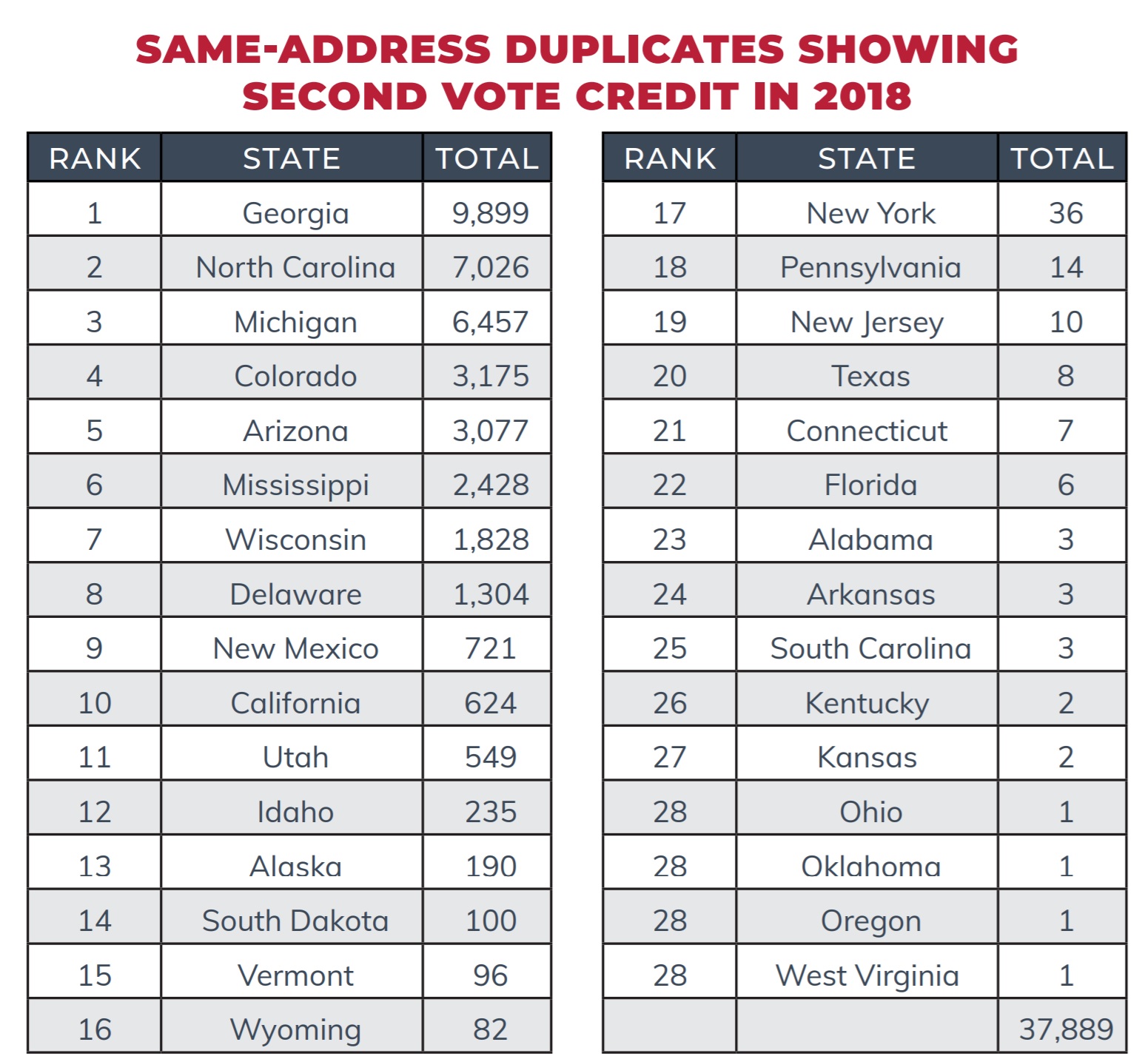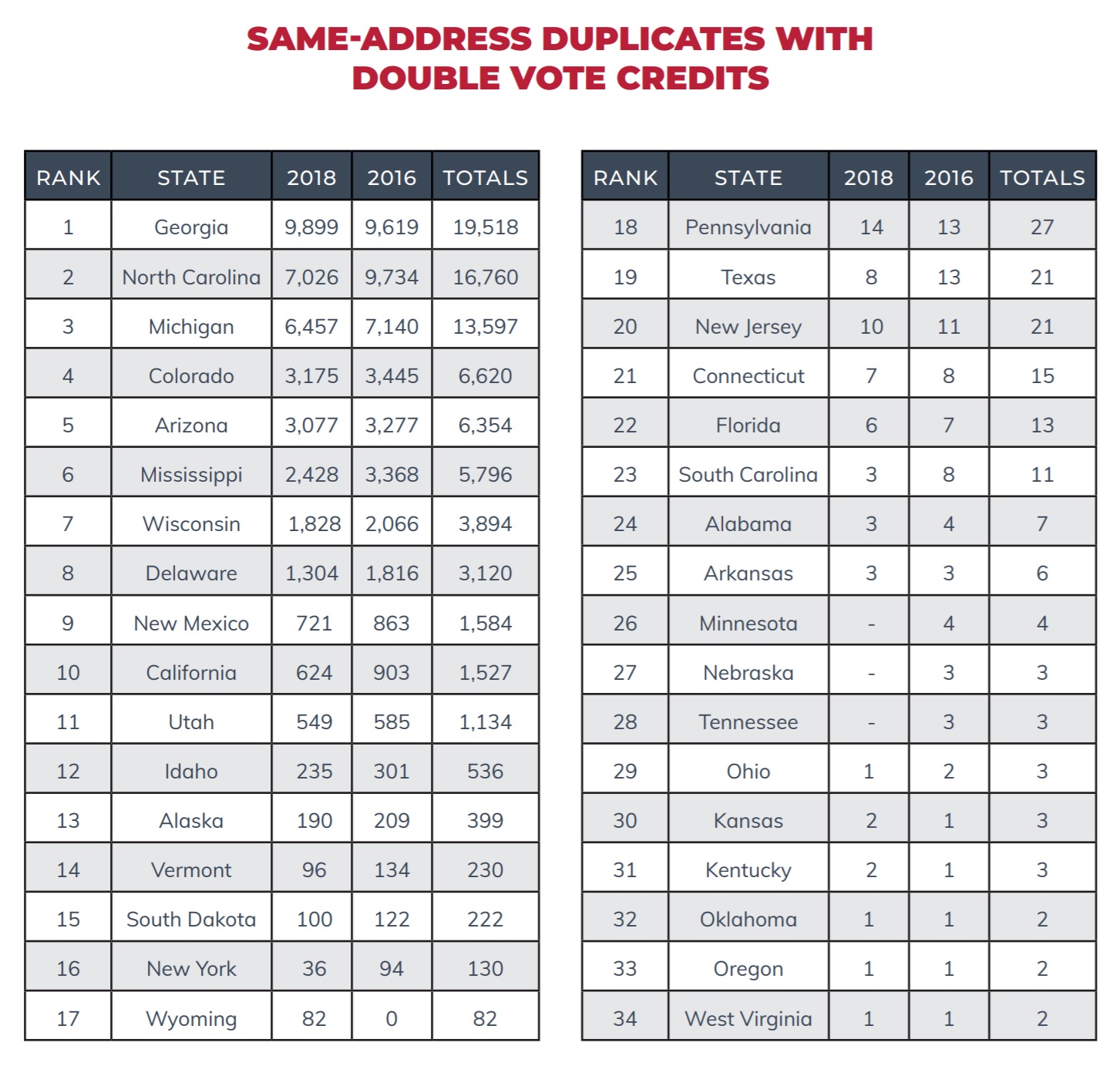Were Insecure Voting Processes This Year’s ‘Insurance Policy’ For Democrats?
Democrats spent 2020 insisting they would not only win the presidency in a landslide but ride a “blue wave” through Congress. If they were truly that confident Joe Biden could become leader of the world through Zoom calls from his basement, then why did Democrats blanket the country with millions of dollars to alter election processes in ways that are known to substantially increase errors and fraud to within election-tipping margins?
The Russia collusion investigation uncovered text messages calling Barack Obama’s intelligence agencies spying on Donald Trump’s campaign an “insurance policy” against the “risk” Trump might win. What “insurance policies” did Democrats take out in 2020?
Democrats’ allies in big tech rigged search results and online conversations to hide news harmful to Biden. Their allies in big media refused to report on stories harmful to Biden or to ask him difficult questions. An election-overturning number of Biden voters say they would not have supported him had they been better informed of stories big tech banned and corporate media panned.
And then there is 2020’s stampede into mass mail-in voting under the guise of COVID. Mail-in voting increases fraud and error rates to within election-winning margins, as well as the ability to manipulate election outcomes by contesting ballots.
No one can blame voters for being confused before, during, or after the election. It was confusing. It is confusing. Democrats filed the lawsuits that caused the uncertainty, decided they would simply declare victory amid the ongoing chaos they deliberately created, and let media and courts seal the steal. It worked perfectly — except that the election was so unexpectedly close, people noticed.
Research: Mail-In Means More Errors than In-Person
Democrats used COVID as an excuse to ram through many long-desired weaker voting processes, to the point that an estimated 80 million Americans voted by mail in fall 2020. (Only estimates are available currently, Claire DeSoi, a spokeswoman for the MIT Election Data and Science Lab, told me in an email.) That’s approximately half of the 2020 presidential election’s estimated 160 million votes.
In 2016, approximately 24 percent of votes were cast by mail, according to federal data. That means mail-in voting approximately doubled between 2016 and 2020 as a percent of vote share. It likely more than doubled as a proportion of vote totals due to 2020’s higher turnout. By any measure, 2020 saw an enormous expansion of mail-in voting.
That represents a problem for election integrity, because mail-in necessarily includes much higher error rates and opportunities for fraud than in-person votes. It can’t help but do that. Too many more things can go wrong with a mail-in vote than an in-person one, as studies invariably point out.
“Voting by mail lacks the protections that voting in person provides,” summarizes Texas Public Policy Foundation vice president Chuck DeVore in a September 2020 study. “The ballot can get lost; no voter identification is required; and the ballot is vulnerable to fraud, voter intimidation, or deception.”
A September 2020 article published in the Election Law Journal explains how mail-in significantly increases the potential for disqualifying errors: “From requesting and then receiving a ballot, to correctly filling it out, to placing the completed ballot in a secrecy envelope that is then inserted into an official return envelope, to filling out and signing a voter’s certificate (or even having a witness sign) on the back of a return envelope, there are multiple ways a mail ballot may leak out of the ‘voting pipeline.'”
The Increased Fraud Possibilities Are Real
None of these expanded opportunities for error exist for in-person voting. Neither do mail delays or failures, which have contributed to the 28 million U.S. ballots that have gone missing between 2012 and 2018. For November 2020, 92 million voters requested a mail-in ballot and an estimated 26 million did not return one of these by Nov. 6, according to the U.S. Elections Project. Where that 26 million went, nobody knows.
What is known is that millions of unused mail-in ballots laying about make either overt fraud or fraudulent manipulation of votes more possible and therefore likely. One-hundred-dollar bills are safer in a bank than on a sidewalk. So are ballots. One fraud-ripe process that stems from mass mail-in balloting is vote-harvesting, which California recently legalized.
Vote harvesting is when (often paid) political operatives go door to door collecting ballots. This can influence elections not only by allowing more possibilities for outright fraud by ballot-stuffing, tossing, altering, influencing voters, and other manipulation, but also by giving political factions power to increase their vote tallies if they simply have more money to collect votes than the other team does.
Vote harvesting is driven by political actors realizing, “If there’s so many ballots out there in the wind unaccounted for by election officials, surely some manpower could be dedicated to go bring them in,” Public Interest Legal Foundation spokesman Logan Churchwell told RealClearPolitics’s Mark Hemingway in April.
“To illustrate the risk, Churchwell notes that in 2016 Hillary Clinton won the popular vote by garnering over 2.8 million more votes than Donald Trump,” Hemingway writes. “But nearly 6 million unaccounted mail-in ballots were never counted in 2016, more than twice her margin in the popular vote. The potential to affect elections by chasing down unused mail-in ballots and make sure they get counted – using methods that may or may not be legal – is great.”
Since by nature criminal activity is secret and much of it never uncovered, “We have no systematic measures of fraud,” notes a 2008 Massachusetts Institute of Technology report about election integrity, “but fraud appears to be especially difficult to regulate in absentee systems. In-precinct voting or ‘kiosk’ voting is observable. Absentee voting is not.”
While in 2020 Democrats and the media have openly scoffed at the idea that any fraud ever happens in elections — CNN’s running video Wednesday called the very idea “the vote fraud myth” — fraud not only happens, it has been institutionalized at different points in American history and in different locations. The Federalist has documented numerous widespread instances of 2020 vote fraud, including in Nevada, Arizona and Wisconsin, Pennsylvania, Michigan, Georgia, and Michigan (again).
“The U.S. historically has had problems of largescale fraud. Machine politics in the nineteenth century involved coordinated, large-scale activities to alter vote tallies, to cast illegal votes, and to destroy ballots,” the MIT study says. “Such coordinated activities could alter thousands of ballots. Small-scale fraud is also a concern in close elections,” it continues, before identifying “two broad types of security problems” with mail-in systems: “manipulation of voters and tampering with the recording of votes and counting mechanisms.”
Fraud or Error? Mail-In Amps Election Worker Influence
The Election Law Journal authors note mail-in dramatically increases possibilities for ballot-influencing by election officials, either purposefully or accidentally: “potentially thousands of local election officials have the opportunity to exercise discretion when determining whether a signature on an VBM ballot envelope should be accepted or rejected.” The study noted that ballot-rejection rates can vary widely within a state, affecting the Equal Protection constitutional concerns at the heart of the Trump campaign’s lawsuit in Pennsylvania.
That study also found first-time mail-in votes have average rejection rates of more than 3 percent due to errors like missing secrecy envelopes and signature mismatches. More than 4 percent of military absentee ballots were rejected in Florida in 2018.
Studies also find vote cancellations by local officials are especially heightened when voters haven’t done mail-in before, precisely what happened this year. An October 2020 study examined Florida voters in recent elections. The authors calculated that, “Roughly speaking, voters inexperienced with mail voting are close to three times as likely to cast a rejected ballot than are voters who are experienced with this form of voting” (emphasis added).
That never happens when people vote in person, the authors note: “There is simply no such thing as a regular ballot cast in person by an eligible voter that is later rejected.” Rejection rates of mail-in votes can easily tip elections, as constitutional law professor and CNN analyst Richard Pildes pointed out in September: “In recent primaries, for example, nearly 4% of absentees were rejected in Philadelphia; 8% in Kentucky; and 20% in parts of New York City.”
Higher rejection rates to the point of being able to change an election outcome destroys voter confidence in election results, especially given the party affiliation imbalance in mail-in. According to the U.S. Elections Project, registered Democrats requested 44.1 percent of mail-in ballots while registered Republicans requested 26.7 percent.
Pildes gave an example of how this inflames civic distrust: “Imagine if the outcome in Michigan is close, and 75% of Biden supporters vote absentee, yet 10% or more of those ballots are rejected. Or that tens of thousands of absentee ballots mailed back do not get delivered in time to be valid. Biden supporters will surely erupt in fury, viewing the election as illegitimate.” That is why, Pildes concluded, “Voting in person is the single most effective action voters can take to reduce the risk of election turmoil.”
These Error Rates Can and Do Change Election Results
While some error rates look small, electoral victories are often within the margin of error that vote-by-mail expands. So it is a plain fact that mail-in voting increases doubt about election outcomes, as well as opportunities to fraudulently flip outcomes either through error or litigation.
Pennsylvania’s mail-vote error rate was known to be well within the victory margin before the election, partly because of all the changes Democrats made to weaken voting integrity. Democrats demanded before the votes came in that all mail-in ballots without secrecy envelopes be counted, even though that violates state law. The changes Democrats demanded were estimated to affect up to 200,000 ballots. In 2016, Trump won Pennsylvania by 44,000 votes. In 2020, CNN claims Biden won Pennsylvania by 81,000 votes.
“If at least 3 million people in Pennsylvania vote by mail in the Nov. 3 election, as expected, just 1% of that is 30,000 ballots, while 5% is 150,000 ballots. If 4 million people vote by mail, 5% is 200,000 ballots,” noted the Associated Press in August.
So when margins of a few percentage points — or, as in 2020, of less than 1 percent in multiple key Electoral College states– separate winner from loser, mail-in errors can easily change the election results. And no one would ever know, or be able to know, since the errors are so diffuse throughout the voting process, and may be well-intentioned.
Even Tiny Error Rates Can Flip Elections
Sometimes elections are extremely close, such that even tiny error rates can change the outcome.
“Every vote cast can affect the outcome of the election. Every ballot that is rejected could also potentially swing the election and the Electoral College. Rejected ballots can be the margin of error that swings the election results in certain states,” Hannah Fried of All Voting is Local told Salon in October.
Just this year, a New York U.S. House seat is reportedly within a 100-vote margin. One candidate brought the margin that close by winning three-fourths of the mail-in ballots, according to The New York Times. Due to errors from mail-in ballots and local elections officials, a judge will decide that race, instead of voters.
In Iowa, another U.S. House race has reportedly come down to a margin of six votes after a recount. Before the recount, the margin was 47 votes. All elections are important because they are how we govern ourselves, but the House is especially fraught this year because Democrats’ majority is paper-thin. Every single tipped House race will have a butterfly effect on what happens in Congress for two years.
The New York Times reported in September that nearly 100,000 defective mail-in ballots were sent to New York City voters. If this had happened in Wisconsin, Pennsylvania, Arizona, Nevada, or Georgia and many of those voters unknowingly sent back bad ballots, it could have tipped the presidential electors of that state.
In all those states, Trump reportedly lost by fewer than 50,000 votes. All the margins in those states were less than 1 percent, or well within the margin for being flipped by mass mail-in balloting error rates. Mail-in error margins combined with tight races like this are how lawyers win elections instead of honest ballot counts. That is Democrats’ real strategy.
Democrats Pushed For Higher Error Rates Before Election
Of the more than 300 lawsuits waged pre-election to use courts to alter voting laws with COVID as a pretext, the vast majority originated from Democrats and allied organizations. Of the 160 pending cases lawyer Hans von Spakovsky examined in August, just 40 involved Republicans, and of those, many involved Republicans only because Democrats had sued them.
“Their objective: force all-mail elections or huge increases in absentee balloting while simultaneously eliminating safeguards against abuse and fraud,” von Spakovsky concluded. He summarized the hundreds of lawsuits pre-emptively filed by Democrat Party appendages around the country as:
- “get rid of voter ID and witness signature or notarization requirements for absentee ballots;
- “override state deadlines for absentee ballots to be either returned or postmarked by Election Day;
- “void state laws banning vote harvesting by third parties;
- “stop or erode signature comparison procedures.”
As explained above, all of these are proven to reduce election accuracy, sometimes to outcome-altering levels. All the post-election lawsuits from the Trump campaign involve states’ widespread failure to enact security measures recommended by the National Council of State Legislatures for reducing mail-in error and fraud rates.
These include signature verification; regularly cleaned voter rolls; open and bipartisan access to all processing of ballots; secure “chain of custody” for ballots; physical security such as locks and cameras; mechanisms to prevent double-voting; bans on vote harvesting; and serious punishments for fraud and ballot tampering.
Multiple problems in these categories have been alleged in the post-election Wisconsin, Michigan, Georgia, Arizona, and Pennsylvania lawsuits, and attested to by more than 100 eyewitness affidavits. The deeply contested states Pennsylvania and Michigan have been among the several that fought pre-election efforts to clean tens of thousands of ineligible voters from their registration lists. Democrat lawyers have been the ones fighting these basic and obvious election integrity measures, among dozens of others, according to a September 2020 report by the Public Interest Legal Foundation.



Democrats’ 2020 election confusion operation has been led by the same outfit that helped manufacture the Russian collusion hoax: the law firm Perkins Coie. Marc Elias, Perkins Coie’s head of election law, is also the Democratic National Committee’s election lawyer, and he’s been spearheading many of these election-weakening lawsuits while claiming to be fighting “voter suppression.” In 2009, Elias got Minnesota Sen. Norm Coleman’s narrow 2008 victory reversed in court so Al Franken could take his seat.
Elias was also general counsel to the Hillary Clinton campaign in 2016. The Washington Post identified him in 2017 as the man who commissioned Fusion GPS to craft its dossier of lies used as a pretext for assaulting the results of the 2016 election through U.S. intelligence agencies with the Russia collusion hoax. In 2020, he focused on undermining the election a different way.
Democrats’ election-tampering happened in plain sight. It consisted of demanding, and getting, a chaotic mess of constantly changing voting rules layered atop early in-person and mail-in voting that started long before election day.
“With less than six weeks until Election Day,” The New York Times reported on Sept. 24, “laws governing how Americans vote remain in flux in many battleground states, with the two parties locked in an intensive fight over the rules.” It later noted, “The uncertainty has forced the Wisconsin Elections Commission to plan for multiple regulations even as it sends out 2.7 million pieces of mail to voters with election information.” This purposeful confusion was a smokescreen for ensuring a Democrat victory.
COVID Was This Year’s Excuse to Confuse the Election
Democrats inflamed COVID with false and exaggerated claims that played on the American people’s fears rather than our prudence and courage, all to get Trump. Just like false “Russian collusion” was their pretext for undermining the 2016 results, COVID was their pretext for undermining the 2020 results.
On Nov. 2, after approximately half the votes in the 2020 election had been cast, the Centers for Disease Control told the public that people with a live COVID infection could safely vote in person on Nov. 3 after Democrats had spent the entire year telling courts, lawmakers, and the public this scarified scenario was the reason we needed to drastically weaken election processes and vote from home.
What a joke. Just like Spygate, this entire thing has been one information operation layered on top of another. Enough people fell for it that now about half the country has no confidence that the election results we are told are the genuine results voters intended. And you know what? They’re right.
We’ll never know the real result, though, thanks to mail-in ballots. And that was the goal all along.





Post a Comment